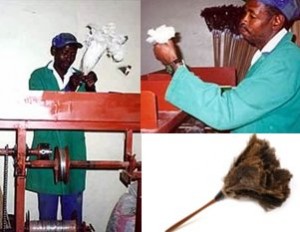Ostrich feathers were responsible for the birth of farmed Ostrich and saved the specie, as Ostrich were on the point of extinction just for their feathers. The domestication of Ostrich started to satisfy the demand for feathers. The domestication of Ostrich stopped the hunting of ostrich threatened with extinction. Drawings and carvings indicate the Ancient Egyptians and Romans used Ostrich feathers for formal dress.
The industry collapsed at the outbreak of the First World War. The primary reason was the stopping of all trade shipping, which left it impossible to service the markets. This combined with the advent of the motorcar and a change in fashions. Prior to the collapse, feathers were extremely valuable creating great wealth. It was the 4th largest export from South Africa by value after Gold, Diamonds and Wool.
The feather market reawakened after the Second World War and has steadily grown since that time. However, the demand for the Leather drove the main growth of the industry since the Second World War. Further development of the feather market is limited by the limited and irregular supply. In value, feathers are less than 5% of the total value of the slaughter bird.
Feathers today are harvested from slaughter birds after slaughter. In South Africa there are adult birds maintained especially for the quality of their feathers. These feathers are taken from the breeders by clipping where there is no blood in the quill (similar to cutting toe and finger nails). To give an indication of size of the best feathers, the farmer holding the wings in Figure 1 is 6ft 3in (1.9m).
Figure 1: Red Male Wing Feathers
These are the type of feathers used by show girls and in carnivals – Figure 2 show several examples.
Figure 2: Ostrich Feathers on Show
There are many different types of feathers based on where they are on the bird, such as tail, wings or body and the age of the bird, chick or mature bird. Sex also determines the colour of the feathers as mature males have black feathers and mature hens feather’s are grey.
Figure 3: Adult Male and Femina Feathers
Figure 3 illustrates dyed male and female (called femina) feathers .Understanding Feather Quality and Styles provides explanations of the different quality and types of feathers.
Figure 4 illustrates how ostrich feather dusters are manufactured in South Africa. Feather dusters come in many different styles and sizes. They are especially good for dusting as the feathers are very soft and the barbs are free as the birds do not fly.
Summary
The most common way to sell feathers is by the kilo in the different categories to those companies wishing to manufacture products. However there are occasions for selling by the individual feather for those who want them for non-industrial uses.
See also Ostrich Feather Structure and Quality


